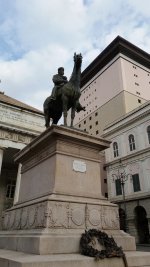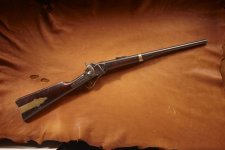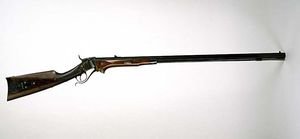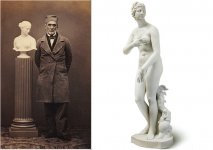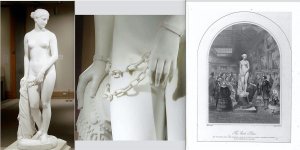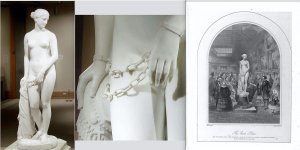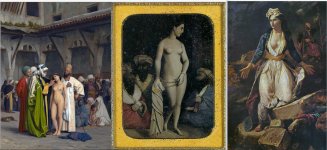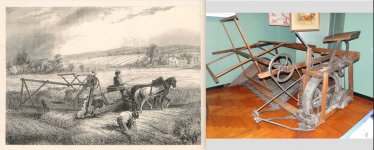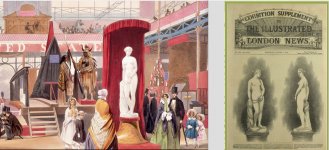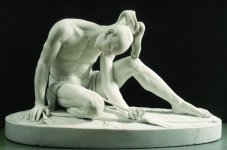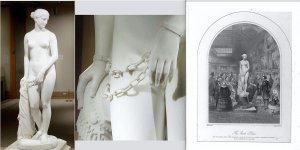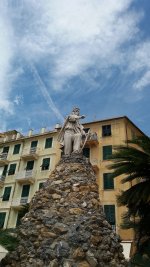Part 19A Powers Greek Slave and American Slavery At The Crystal Palace Exhibition London 1851
Introduction:
When Hiram Powers was sculpting The Greek Slave in his studio in Florence in the 1840s, the American capitalist economy was expanding through its participation in what Harvard historian Sven Beckert has called the Empire of Cotton. There were two components to this economic boom: the agricultural slave labor of the South that grew the cotton for their planter/masters and the industrial wage labor in the North that turned the raw cotton into thread and fabric. The cotton produced in the South was also shipped to England where it supplied the textile mills of Manchester and Lancashire. Although Britain had abolished slavery in 1833, in the decades prior to the outbreak of the Civil War, it was dependent on the labor of American slaves to supply raw cotton to its factories. It is therefore significant that when Powers Greek Slave was included among the American exhibit at the Great Exhibition of the Works of Industry of All Nations held in London's Crystal Palace in 1851, that the sculpture was given alternative interpretations.These will be discussed in an upcoming post.
The Crystal Palace and the Great Exhibition:
The Great Exhibition of 1851 was the first World's Fair of its kind. It was an important symbol of modernity. It was held at London's Hyde Park, in England where the Industrial Revolution had its beginnings. The Exhibition's purpose was to display the idea of progress especially in the areas of science, technology, manufacturing, and the arts. The latter was illustrated by the Crystal Palace itself. Designed by the English architect Joseph Paxton, it was constructed from cast iron and plate-glass, both products of industrial technology. The building measured 1,851 feet in length and its interior was 128 feet high. Exhibition space was over 900,000 square feet.The glass walls and ceiling eliminated the need for interior lighting. The world's 100,000 products sent to the exhibition represented over 15,000 exhibitors. Each nation wanted to show off examples of its representative and most advanced products. The building got its name from two factors: Crystal because of the use of glass and Palace because the exhibition was the idea of Prince Albert, the husband of Queen Victoria.
American Manufactures at the Crystal Palace:
Although America was a new nation compared to the European nations represented at the fair, it nevertheless was already industrializing and producing manufactured goods that would attain worldwide reputations. Three examples of American products displayed at the Crystal Palace are illustrated below: a Colt Revolver, a Bowie Knife, and the McCormick Reaper that revolutionized the collection of hay for the farmer. American innovators from the latter half of the 19th Century such as Thomas Edison and Alexander Graham Bell would produce a variety of products such as the light bulb , phonograph and telephone that would make major contributions at home and abroad. The items at the 1851 exhibition were a preview of these things to come.
The Greek Slave at the Crystal Palace:
Powers Greek Slave was the most prominent American sculpture at
the exhibition. It appeared on the front page of the August 8th,1851 issue of the widely read London Illustrated News helping to draw fair goers to the exhibition. As discussed in an earlier post, Britain's most famous Romantic poet, Lord Byron, had participated along with other British volunteers in coming to the aid of the Greeks besieged by the Ottoman Turks. As a result, the subject increased local interest in viewing the sculpture.
As may be seen in the attached illustration, the statue was set on a stage-like platform placed in its own “theatrical” setting of a red curtain. The monumentality of the sculpture was enhanced by a second pedestal. It was placed in front of a tableau of an Indian chief and his squaw. Related to the latter was a marble sculpture by Anglo-American artist Peter Stephenson entitled The Wounded or Dying Indian done between 1848 and 1850. Stephenson had been born in England but came of age in the United States. Like Powers he eventually moved to Italy. The Indian was created in his studio in Rome. This exotic American Indian subject would have appealed to a European audience. Stephenson created the work at a time when the Indian was viewed as an example of the Noble Savage. The theme of the Dying Indian foreshadowed the subject of the Vanishing Indian that was popularized by American artists and photographers at the end of the 19th Century.
Illustrations:
1.Exterior and Interior of the Crystal Palace London May 1 to October 1 1851
2.Colt Revolver 1851 Bowie Knife
3.McCormick Mechanical Reaper 1851
4.Powers Greek Slave at the Crystal Palace and on the Cover of the August 5, 1851 London Illustrated News
5. Wounded Indian 1848-50 by Peter Stephenson
To Be Continued: Next Time--New Ways of Looking at The Greek Slave


